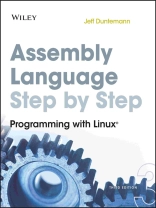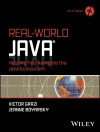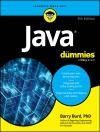The eagerly anticipated new edition of the bestselling introduction to x86 assembly language
The long-awaited third edition of this bestselling introduction to assembly language has been completely rewritten to focus on 32-bit protected-mode Linux and the free NASM assembler. Assembly is the fundamental language bridging human ideas and the pure silicon hearts of computers, and popular author Jeff Dunteman retains his distinctive lighthearted style as he presents a step-by-step approach to this difficult technical discipline.
He starts at the very beginning, explaining the basic ideas of programmable computing, the binary and hexadecimal number systems, the Intel x86 computer architecture, and the process of software development under Linux. From that foundation he systematically treats the x86 instruction set, memory addressing, procedures, macros, and interface to the C-language code libraries upon which Linux itself is built.
-
Serves as an ideal introduction to x86 computing concepts, as demonstrated by the only language directly understood by the CPU itself
-
Uses an approachable, conversational style that assumes no prior experience in programming of any kind
-
Presents x86 architecture and assembly concepts through a cumulative tutorial approach that is ideal for self-paced instruction
-
Focuses entirely on free, open-source software, including Ubuntu Linux, the NASM assembler, the Kate editor, and the Gdb/Insight debugger
-
Includes an x86 instruction set reference for the most common machine instructions, specifically tailored for use by programming beginners
-
Woven into the presentation are plenty of assembly code examples, plus practical tips on software design, coding, testing, and debugging, all using free, open-source software that may be downloaded without charge from the Internet.
Содержание
Introduction: ‘‘Why Would You Want to Do That?’’ xxvii
Chapter 1 Another Pleasant Valley Saturday 1
It’s All in the Plan 1
Steps and Tests 2
More Than Two Ways? 3
Computers Think Like Us 4
Had This Been the Real Thing 4
Do Not Pass Go 5
The Game of Big Bux 6
Playing Big Bux 8
Assembly Language Programming As a Board Game 9
Code and Data 10
Addresses 11
Metaphor Check! 12
Chapter 2 Alien Bases 15
The Return of the New Math Monster 15
Counting in Martian 16
Dissecting a Martian Number 18
The Essence of a Number Base 20
Octal: How the Grinch Stole Eight and Nine 20
Who Stole Eight and Nine? 21
Hexadecimal: Solving the Digit Shortage 24
From Hex to Decimal and from Decimal to Hex 28
From Hex to Decimal 28
From Decimal to Hex 29
Practice. Practice! PRACTICE! 31
Arithmetic in Hex 32
Columns and Carries 35
Subtraction and Borrows 35
Borrows across Multiple Columns 37
What’s the Point? 38
Binary 38
Values in Binary 40
Why Binary? 42
Hexadecimal As Shorthand for Binary 43
Prepare to Compute 44
Chapter 3 Lifting the Hood 45
RAXie, We Hardly Knew Ye 45
Gus to the Rescue 46
Switches, Transistors, and Memory 47
One If by Land 48
Transistor Switches 48
The Incredible Shrinking Bit 50
Random Access 52
Memory Access Time 53
Bytes, Words, Double Words, and Quad Words 54
Pretty Chips All in a Row 55
The Shop Foreman and the Assembly Line 57
Talking to Memory 58
Riding the Data Bus 59
The Foreman’s Pockets 60
The Assembly Line 61
The Box That Follows a Plan 61
Fetch and Execute 63
The Foreman’s Innards 64
Changing Course 65
What vs. How: Architecture and Microarchitecture 66
Evolving Architectures 67
The Secret Machinery in the Basement 68
Enter the Plant Manager 70
Operating Systems: The Corner Office 70
BIOS: Software, Just Not as Soft 71
Multitasking Magic 71
Promotion to Kernel 73
The Core Explosion 73
The Plan 74
Chapter 4 Location, Location, Location 77
The Joy of Memory Models 77
16 Bits’ll Buy You 64K 79
The Nature of a Megabyte 82
Backward Compatibility and Virtual 86 Mode 83
16-Bit Blinders 83
The Nature of Segments 85
A Horizon, Not a Place 88
Making 20-Bit Addresses out of 16-Bit Registers 88
16-Bit and 32-Bit Registers 90
General-Purpose Registers 91
Register Halves 93
The Instruction Pointer 95
The Flags Register 96
The Three Major Assembly Programming Models 96
Real Mode Flat Model 97
Real Mode Segmented Model 99
Protected Mode Flat Model 101
What Protected Mode Won’t Let Us Do Anymore 104
Memory-Mapped Video 104
Direct Access to Port Hardware 105
Direct Calls into the BIOS 106
Looking Ahead: 64-Bit ‘‘Long Mode’’ 106
64-Bit Memory: What May Be Possible Someday vs. What We Can Do Now 107
Chapter 5 The Right to Assemble 109
Files and What’s Inside Them 110
Binary Files vs. Text Files 111
Looking at File Internals with the Bless Editor 112
Interpreting Raw Data 116
‘‘Endianness’’ 117
Text In, Code Out 121
Assembly Language 121
Comments 124
Beware ‘‘Write-Only’’ Source Code! 124
Object Code and Linkers 125
Relocatability 128
The Assembly Language Development Process 128
The Discipline of Working Directories 129
Editing the Source Code File 131
Assembling the Source Code File 131
Assembler Errors 132
Back to the Editor 133
Assembler Warnings 134
Linking the Object Code File 135
Linker Errors 136
Testing the .EXE File 136
Errors versus Bugs 137
Are We There Yet? 138
Debuggers and Debugging 138
Taking a Trip Down Assembly Lane 139
Installing the Software 139
Step 1: Edit the Program in an Editor 142
Step 2: Assemble the Program with NASM 143
Step 3: Link the Program with LD 146
Step 4: Test the Executable File 147
Step 5: Watch It Run in the Debugger 147
Ready to Get Serious? 153
Chapter 6 A Place to Stand, with Access to Tools 155
The Kate Editor 157
Installing Kate 157
Launching Kate 158
Configuration 160
Kate Sessions 162
Creating a New Session 162
Opening an Existing Session 163
Deleting or Renaming Sessions 163
Kate’s File Management 164
Filesystem Browser Navigation 165
Adding a File to the Current Session 165
Dropping a File from the Current Session 166
Switching Between Session Files in the Editor 166
Creating a Brand-New File 166
Creating a Brand-New Folder on Disk 166
Deleting a File from Disk (Move File to Trash) 166
Reloading a File from Disk 167
Saving All Unsaved Changes in Session Files 167
Printing the File in the Editor Window 167
Exporting a File As HTML 167
Adding Items to the Toolbar 167
Kate’s Editing Controls 168
Cursor Movement 169
Bookmarks 169
Selecting Text 170
Searching the Text 171
Using Search and Replace 172
Using Kate While Programming 172
Creating and Using Project Directories 173
Focus! 175
Linux and Terminals 176
The Linux Console 176
Character Encoding in Konsole 177
The Three Standard Unix Files 178
I/O Redirection 180
Simple Text Filters 182
Terminal Control with Escape Sequences 183
So Why Not GUI Apps? 185
Using Linux Make 186
Dependencies 187
When a File Is Up to Date 189
Chains of Dependencies 189
Invoking Make from Inside Kate 191
Using Touch to Force a Build 193
The Insight Debugger 194
Running Insight 195
Insight’s Many Windows 195
A Quick Insight Run-Through 197
Pick Up Your Tools 200
Chapter 7 Following Your Instructions 201
Build Yourself a Sandbox 201
A Minimal NASM Program 202
Instructions and Their Operands 204
Source and Destination Operands 204
Immediate Data 205
Register Data 207
Memory Data 209
Confusing Data and Its Address 210
The Size of Memory Data 211
The Bad Old Days 211
Rally Round the Flags, Boys! 212
Flag Etiquette 215
Adding and Subtracting One with INC and DEC 215
Watching Flags from Insight 216
How Flags Change Program Execution 218
Signed and Unsigned Values 221
Two’s Complement and NEG 221
Sign Extension and MOVSX 224
Implicit Operands and MUL 225
MUL and the Carry Flag 227
Unsigned Division with div 228
The x86 Slowpokes 229
Reading and Using an Assembly Language Reference 230
Memory Joggers for Complex Memories 230
An Assembly Language Reference for Beginners 231
Flags 232
NEG: Negate (Two’s Complement; i.e., Multiply by -1) 233
Flags affected 233
Legal forms 233
Examples 233
Notes 233
Legal Forms 234
Operand Symbols 234
Examples 235
Notes 235
What’s Not Here 235
Chapter 8 Our Object All Sublime 237
The Bones of an Assembly Language Program 237
The Initial Comment Block 239
The .data Section 240
The .bss Section 240
The .text Section 241
Labels 241
Variables for Initialized Data 242
String Variables 242
Deriving String Length with EQU and $ 244
Last In, First Out via the Stack 246
Five Hundred Plates per Hour 246
Stacking Things Upside Down 248
Push-y Instructions 249
POP Goes the Opcode 251
Storage for the Short Term 253
Using Linux Kernel Services Through INT 80 254
An Interrupt That Doesn’t Interrupt Anything 254
Getting Home Again 259
Exiting a Program via INT 80h 260
Software Interrupts versus Hardware Interrupts 261
INT 80h and the Portability Fetish 262
Designing a Non-Trivial Program 264
Defining the Problem 264
Starting with Pseudo-code 265
Successive Refinement 266
Those Inevitable ‘‘Whoops!’’ Moments 270
Scanning a Buffer 271
‘‘Off By One’’ Errors 273
Going Further 277
Chapter 9 Bits, Flags, Branches, and Tables 279
Bits Is Bits (and Bytes Is Bits) 279
Bit Numbering 280
‘‘It’s the Logical Thing to Do, Jim ’’ 280
The AND Instruction 281
Masking Out Bits 282
The OR Instruction 283
The XOR Instruction 284
The NOT Instruction 285
Segment Registers Don’t Respond to Logic! 285
Shifting Bits 286
Shift By What? 286
How Bit Shifting Works 287
Bumping Bits into the Carry Flag 287
The Rotate Instructions 288
Setting a Known Value into the Carry Flag 289
Bit-Bashing in Action 289
Splitting a Byte into Two Nybbles 292
Shifting the High Nybble into the Low Nybble 293
Using a Lookup Table 293
Multiplying by Shifting and Adding 295
Flags, Tests, and Branches 298
Unconditional Jumps 298
Conditional Jumps 299
Jumping on the Absence of a Condition 300
Flags 301
Comparisons with CMP 301
A Jungle of Jump Instructions 302
‘‘Greater Than‘‘ Versus ’’Above’’ 303
Looking for 1-Bits with TEST 304
Looking for 0 Bits with BT 306
Protected Mode Memory Addressing in Detail 307
Effective Address Calculations 308
Displacements 309
Base + Displacement Addressing 310
Base + Index Addressing 310
Index × Scale + Displacement Addressing 312
Other Addressing Schemes 313
LEA: The Top-Secret Math Machine 315
The Burden of 16-Bit Registers 317
Character Table Translation 318
Translation Tables 318
Translating with MOV or XLAT 320
Tables Instead of Calculations 325
Chapter 10 Dividing and Conquering 327
Boxes within Boxes 328
Procedures As Boxes for Code 329
Calling and Returning 336
Calls within Calls 338
The Dangers of Accidental Recursion 340
A Flag Etiquette Bug to Beware Of 341
Procedures and the Data They Need 342
Saving the Caller’s Registers 343
Local Data 346
More Table Tricks 347
Placing Constant Data in Procedure Definitions 349
Local Labels and the Lengths of Jumps 350
’’Forcing’’ Local Label Access 353
Short, Near, and Far Jumps 354
Building External Procedure Libraries 355
Global and External Declarations 356
The Mechanics of Globals and Externals 357
Linking Libraries into Your Programs 365
The Dangers of Too Many Procedures and Too Many Libraries 366
The Art of Crafting Procedures 367
Maintainability and Reuse 367
Deciding What Should Be a Procedure 368
Use Comment Headers! 370
Simple Cursor Control in the Linux Console 371
Console Control Cautions 377
Creating and Using Macros 378
The Mechanics of Macro Definition 379
Defining Macros with Parameters 385
The Mechanics of Invoking Macros 386
Local Labels Within Macros 387
Macro Libraries As Include Files 388
Macros versus Procedures: Pros and Cons 389
Chapter 11 Strings and Things 393
The Notion of an Assembly Language String 393
Turning Your ‘‘String Sense’’ Inside-Out 394
Source Strings and Destination Strings 395
A Text Display Virtual Screen 395
REP STOSB, the Software Machine Gun 402
Machine-Gunning the Virtual Display 403
Executing the STOSB Instruction 404
STOSB and the Direction Flag (DF) 405
Defining Lines in the Display Buffer 406
Sending the Buffer to the Linux Console 406
The Semiautomatic Weapon: STOSB without REP 407
Who Decrements ECX? 407
The LOOP Instructions 408
Displaying a Ruler on the Screen 409
MUL Is Not IMUL 410
Adding ASCII Digits 411
Adjusting AAA’s Adjustments 413
Ruler’s Lessons 414
16-bit and 32-bit Versions of STOS 414
MOVSB: Fast Block Copies 414
DF and Overlapping Block Moves 416
Single-Stepping REP String Instructions with Insight 418
Storing Data to Discontinuous Strings 419
Displaying an ASCII Table 419
Nested Instruction Loops 420
Jumping When ECX Goes to 0 421
Closing the Inner Loop 421
Closing the Outer Loop 422
Showchar Recap 423
Command-Line Arguments and Examining the Stack 424
Virtual Memory in Two Chunks 424
Anatomy of the Linux Stack 427
Why Stack Addresses Aren’t Predictable 429
Setting Command-Line Arguments with Insight 429
Examining the Stack with Insight’s Memory View 430
String Searches with SCASB 432
REPNE vs. REPE 435
Pop the Stack or Address It? 436
For Extra Credit 438
Chapter 12 Heading Out to c 439
What’s GNU? 440
The Swiss Army Compiler 441
Building Code the GNU Way 441
How to Use gcc in Assembly Work 443
Why Not gas? 444
Linking to the Standard C Library 445
c calling conventions 446
A Framework to Build On 447
Saving and Restoring Registers 447
Setting Up a Stack Frame 448
Destroying a Stack Frame 450
Characters Out via puts() 451
Formatted Text Outputwithprintf() 452
Passing Parameters to printf() 454
Data In with fgets() and scanf() 456
Using scanf() for Entry of Numeric Values 458
Be a Time Lord 462
The C Library’s Time Machine 462
Fetching time_t Values from the System Clock 464
Converting a time_t Value to a Formatted String 464
Generating Separate Local Time Values 465
Making a Copy of glibc’s tm Struct with MOVSD 466
Understanding AT&T Instruction Mnemonics 470
AT&T Mnemonic Conventions 470
Examining gas Source Files Created by gcc 471
AT&T Memory Reference Syntax 474
Generating Random Numbers 475
Seeding the Generator with srand() 476
Generating Pseudorandom Numbers 477
Some Bits Are More Random Than Others 482
Calls to Addresses in Registers 483
How C Sees Command-Line Arguments 484
Simple File I/O 487
Converting Strings into Numbers with sscanf() 487
Creating and Opening Files 489
Reading Text from Files with fgets() 490
Writing Text to Files with fprintf() 493
Notes on Gathering Your Procedures into Libraries 494
Conclusion: Not the End, But Only the Beginning 503
Where to Now? 504
Stepping off Square One 506
Appendix A Partial x86 Instruction Set Reference 507
Notesonthe Instruction Set Reference 510
AAA: Adjust AL after BCD Addition 512
ADC: Arithmetic Addition with Carry 513
ADD: Arithmetic Addition 515
AND: Logical AND 517
BT: Bit Test 519
CALL: Call Procedure 521
CLC: Clear Carry Flag (CF) 523
CLD: Clear Direction Flag (DF) 524
CMP: Arithmetic Comparison 525
DEC: Decrement Operand 527
DIV: Unsigned Integer Division 528
INC: Increment Operand 529
INT: Software Interrupt 530
IRET: Return from Interrupt 531
J?: Jump on Condition 532
JCXZ: Jump If CX= 0 534
JECXZ: Jump If ECX= 0 535
JMP: Unconditional Jump 536
LEA: Load Effective Address 537
LOOP: Loop until CX/ECX= 0 538
LOOPNZ/LOOPNE: Loop While CX/ECX > 0and ZF=0 540
LOOPZ/LOOPE: Loop While CX/ECX > 0and ZF=1 541
MOV: Move (Copy) Right Operand into Left Operand 542
MOVS: Move String 544
MOVSX: Move (Copy) with Sign Extension 546
MUL: Unsigned Integer Multiplication 547
NEG: Negate (Two’s Complement; i.e., Multiply by -1) 549
NOP: No Operation 550
NOT: Logical NOT (One’s Complement) 551
OR: Logical OR 552
POP: Pop Top of Stack into Operand 554
POPA/POPAD: Pop All GP Registers 555
POPF: Pop Top of Stack into 16-Bit Flags 556
POPFD: Pop Top of Stack into EFlags 557
PUSH: Push Operand onto Top of Stack 558
PUSHA: Push All 16-Bit GP Registers 559
PUSHAD: Push All 32-Bit GP Registers 560
PUSHF: Push 16-Bit Flags onto Stack 561
PUSHFD: Push 32-Bit EFlags onto Stack 562
RET: Return from Procedure 563
ROL: Rotate Left 564
ROR: Rotate Right 566
SBB: Arithmetic Subtraction with Borrow 568
SHL: Shift Left 570
SHR: Shift Right 572
STC: Set Carry Flag (CF) 574
STD: Set Direction Flag (DF) 575
STOS: Store String 576
SUB: Arithmetic Subtraction 577
XCHG: Exchange Operands 579
XLAT: Translate Byte via Table 580
XOR: Exclusive Or 581
Appendix B Character Set Charts 583
Index 587
Об авторе
Jeff Duntemann has been writing about computing for over thirty years, and is the author of numerous books on programming, wireless networking, and system administration. He has been a columnist in Dr. Dobb’s Journal, and has edited well-known programming publications like PC Techniques and Visual Developer. After hours, he enjoys blogging, astronomy, amateur radio, and writing science fiction.











